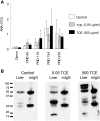Exposure Cessation During Adulthood Did Not Prevent Immunotoxicity Caused by Developmental Exposure to Low-Level Trichloroethylene in Drinking Water
- PMID: 28369519
- PMCID: PMC6075179
- DOI: 10.1093/toxsci/kfx061
Exposure Cessation During Adulthood Did Not Prevent Immunotoxicity Caused by Developmental Exposure to Low-Level Trichloroethylene in Drinking Water
Abstract
Exposure to the water pollutant trichloroethylene (TCE) can promote autoimmunity in both humans and rodents. Using a mouse model we have shown that chronic adult exposure to TCE at 500 μg/ml in drinking water generates autoimmune hepatitis in female MRL+/+ mice. There is increasing evidence that developmental exposure to certain chemicals can be more toxic than adult exposure. This study was designed to test whether exposure to a much lower level of TCE (0.05 μg/ml) during gestation, lactation, and early life generated autoimmunity similar to that found following adult exposure to higher concentrations of TCE. When female MRL+/+ mice were examined at postnatal day (PND) 259 we found that developmental/early life exposure [gestational day 0 to PND 154] to TCE at a concentration 10 000 fold lower than that shown to be effective for adult exposure triggered autoimmune hepatitis. This effect was observed despite exposure cessation at PND 154. In concordance with the liver pathology, female MRL+/+ exposed during development and early life to TCE (0.05 or 500 μg/ml) generated a range of antiliver antibodies detected by Western blotting. Expression of proinflammatory cytokines by CD4+ T cells was also similarly observed at PND 259 in the TCE-exposed mice regardless of concentration. Thus, exposure to TCE at approximately environmental levels from gestational day 0 to PND 154 generated tissue pathology and CD4+ T cell alterations that required higher concentrations if exposure was limited to adulthood. TCE exposure cessation at PND 154 did not prevent the immunotoxicity.
Keywords: autoimmune; developmental exposure and adult disease; trichloroethylene.
© The Author 2017. Published by Oxford University Press on behalf of the Society of Toxicology. All rights reserved. For Permissions, please e-mail: journals.permissions@oup.com.
Figures







References
-
- ATSDR. (2014). Todd, G.D and Wohlers, D.W. Toxicological Profile for Trichloethylene, US Department of Health and Human Services, Public Health Service, Agency for Toxic Substances and Disease Registry.
-
- Bhandari J. C. (1983). Non-reversibility of vinyl chloride carcinogenesis in rodents. Toxicol. Pathol. 11, 181–187. - PubMed
-
- Blossom S. J., Doss J. C. (2007). Trichloroethylene alters central and peripheral immune function in autoimmune-prone MRL(+/+) mice following continuous developmental and early life exposure. J. Immunotoxicol. 4, 129–141. - PubMed
MeSH terms
Substances
Grants and funding
LinkOut - more resources
Full Text Sources
Other Literature Sources
Research Materials

